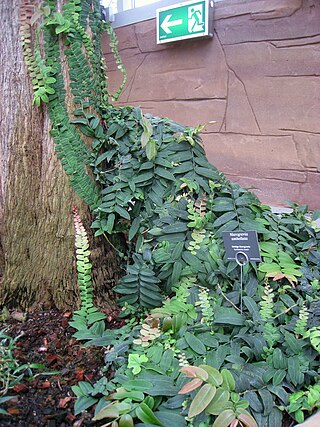
The Marcgraviaceae are a neotropical angiosperm family in the order Ericales. The members of the family are shrubs, woody epiphytes, and lianas, with alternate, pinnately nerved leaves. The flowers are arranged in racemes. The flowers are accompanied by modified, fleshy, saccate bracts which produce nectar. The flowers are pentamerous. The fruits are capsules.
Ardisia schlechteri is a species of flowering plant in family Primulaceae. It is endemic to Cameroon. Its natural habitat is subtropical or tropical dry forests. It is threatened by habitat loss.
Gentianella hypericoides is a species of flowering plant in the family Gentianaceae. It is endemic to Ecuador. Its natural habitat is subtropical or tropical high-altitude shrubland.
Gentianella longibarbata is a species of flowering plant in the family Gentianaceae. It is endemic to Ecuador. Its natural habitat is subtropical or tropical high-altitude grassland.
Gentianella splendens is a species of flowering plant in the family Gentianaceae. It is endemic to Ecuador. Its natural habitats are subtropical or tropical swamps and subtropical or tropical high-altitude shrubland.
Gentianella sulphurea is a species of flowering plant in the family Gentianaceae. It is endemic to Ecuador. Its natural habitat is subtropical or tropical high-altitude shrubland.
Homalium henriquesii is a species of flowering plant in the family Salicaceae.

Jollydora is a genus of plant in family Connaraceae.
Marcgravia crassiflora is a species of flowering plant in the Marcgraviaceae family. It is endemic to Ecuador.

Marcgravia is a genus of plants in the Marcgraviaceae family commonly eaten by the dwarf little fruit bat. The genus is native to the Caribbean Islands, Central America, and South America, and genus is named in memory of the German naturalist Georg Marcgraf. The plant is visited by Thomas's nectar bat.
Marcgravia grandifolia is a species of plant in the Marcgraviaceae family. It is endemic to Ecuador.
Marcgravia polyadenia is a species of plant in the Marcgraviaceae family. The flowering vine is endemic to Ecuador.
Marcgraviastrum gigantophyllum is a species of flowering plant in the family Marcgraviaceae. It is endemic to Ecuador. The vine's natural habitat is subtropical or tropical moist montane areas of the Andes Ecuadorian ranges.
Memecylon candidum is a species of plant in the family Melastomataceae. It is found in Cameroon and Nigeria. It is threatened by habitat loss.
Lagenaria rufa is a [[flowering plant] in the family Cucurbitaceae. It is a climbing vine. Its flowers range from white to yellow. The fruit is a gourd, dark green when developing but becomes cream-orange when ripe. It is native to Western Africa.

Marcgravia umbellata, also called monkey paws, is a species of flowering vine in the family Marcgraviaceae. It is native to the Lesser Antilles islands in the eastern Caribbean and Anguilla. They are part of the guild photoautotroph. Marcgravia umbellata was the first member of the marcgraviaceae family to be described in modern botanical literature.
Marcgravia evenia is a species of flowering vine in the family Marcgraviaceae. Within this family it belongs to the Galetae group, which is characterized by a long inflorescence axis and boat shaped nectaries. The plant is endemic to Cuba. The inflorescence of M. evenia is extraordinary. At the upper end of the pendant inflorescence are several concave bracts set at an angle to reflect and focus sonar pulses from bats, helping the bats to locate the flowers.. In the middle of the inflorescence is a discoid circle of about twenty tubular tetramerous flowers. Below these is a second set of bracts very different from the reflective ones These are modified into extrafloral nectaries which is why the bats are interested, and can be enlisted as pollinators. Inflorescences with two different kinds of bracts are quite rare. although the common poinsettia is one such.

Souroubea is a genus of flowering plants in the family Marcgraviaceae, native to southern Mexico, Central America, Trinidad, and northern South America. Some species are psychophilous, and some are sphingophilous.

Schwartzia is a genus of flowering plants belonging to the family Marcgraviaceae. It is found in tropical parts of South America, mainly within the rainforest. It has greenish, white, reddish or red coloured flowers.
Malesherbia weberbaueri is species of flowering plant in the family Passifloraceae. It is a subshrub native to Apurímac, Ayacucho, Huancavelica and Junín. It is found at altitudes of 2300-3600 meters.





